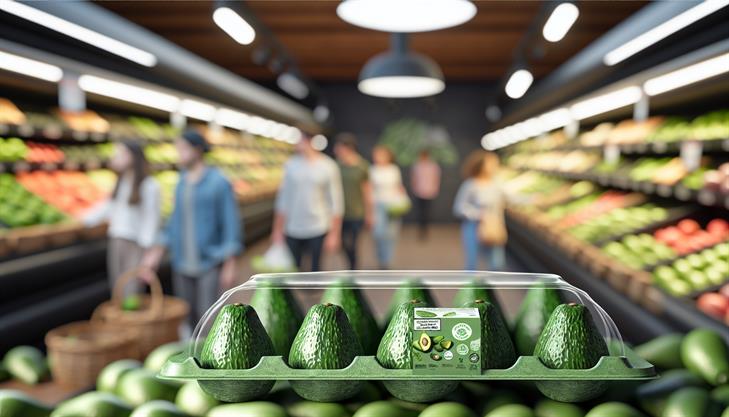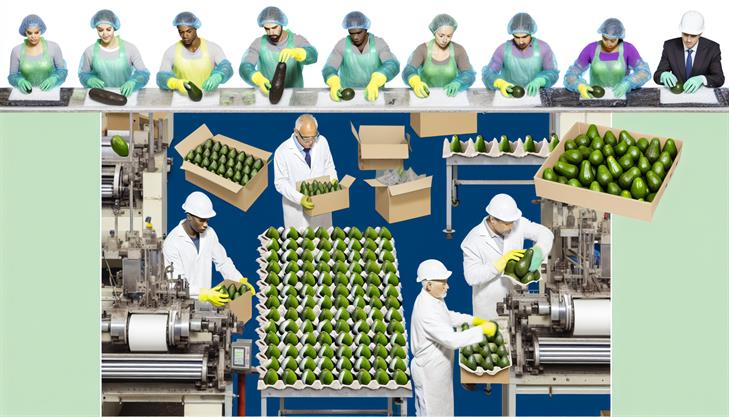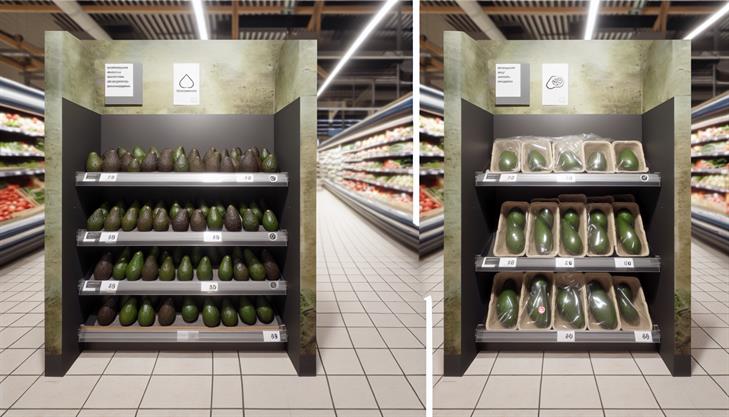In a world striving for sustainability and eco-friendliness, the humble avocado is stepping beyond its role in health-conscious diets and luxurious skincare rituals. Imagine a scenario where the pit and peel of this beloved fruit become the heroes in our quest to reduce plastic waste. Enter the revolutionary concept of avocados in biodegradable packaging. As awareness grows around the environmental toll of conventional plastics, innovative solutions are crucial, and avocados are emerging as a surprisingly viable alternative. This transformation not only addresses our swelling landfills and oceanic pollution but also leverages natural materials in ways many could never have imagined. In this guide, we’ll delve into the remarkable journey of how avocados—often cast aside for their creamy interiors—are being repurposed into sustainable packaging solutions. Discover the science, the companies spearheading this green revolution, and how these advancements might just redefine our packaging norms. By understanding how these green giants fit into the larger sustainability narrative, you’ll grasp the profound impact they can have on our planet’s health and your everyday choices.
Understanding Avocado-Based Biodegradable Materials
Avocados, celebrated for their nutritional benefits, have found an innovative role in creating sustainable, biodegradable packaging. The process of transforming avocados into biodegradable materials involves harnessing both the fruit’s waste components and natural properties. Here’s a detailed look at how avocados are utilized for biodegradable packaging:
1. Sourcing Avocado Waste
The journey begins with sourcing avocado waste, primarily the seeds and skins, which are by-products of the food industry. These parts are usually discarded, contributing to environmental waste. By collecting these remnants, manufacturers can repurpose them effectively, reducing landfill accumulation and tapping into a resource that’s otherwise overlooked.
2. Processing Avocado Seeds and Skins
The collected avocado waste undergoes a cleaning process to remove any residual flesh. The seeds and skins are then dehydrated and ground into a fine powder. This powder serves as the raw material for further processing. The dehydration step is crucial as it prevents mold growth and ensures longevity in storage.
3. Production of Biopolymer
Blending the avocado powder with natural binders like starch or cellulose initiates the creation of a biopolymer. This mixture is heated and molded, taking advantage of the polymers’ natural ability to form a sturdy matrix. This innovative biopolymer forms the backbone of avocado-based packaging materials.
4. Molding and Shaping
The resulting biopolymer is then molded into the desired packaging forms, such as trays, containers, or wrapping films. This phase can involve conventional techniques similar to those used in plastic manufacturing, including extrusion and injection molding. The adaptability of avocado-based biopolymer makes it suitable for various shapes and functions.
5. Quality Testing and Optimization
Before the packaging materials reach consumers, they undergo rigorous testing. This includes assessments for durability, flexibility, and biodegradability to ensure they meet industry standards. During this stage, any necessary adjustments are made to the biopolymer formulation to enhance performance or ecological impact.
Common Issues and Tips
-
Material Consistency: Ensuring consistent quality of avocado powder is crucial. Variations in moisture content can affect the binding process. It’s advisable to monitor dehydration conditions vigilantly.
-
Biodegradability Rate: While these materials are biodegradable, the rate can vary based on environmental conditions. Ensuring end-users understand optimal disposal methods, such as composting, can enhance effectiveness.
-
Scaling Production: One challenge is achieving cost-efficient scalability. Developing partnerships with avocado suppliers and process refinements can help overcome this hurdle.
Additional Advice
For those considering transitioning to avocado-based biodegradable packaging, investing in research and development is crucial. Understanding the properties of avocado-derived biopolymers can open pathways to customized applications and new product lines. Furthermore, staying updated with technological advancements in biodegradable materials will ensure competitive advantage and continued sustainability.
By embracing the use of avocado waste for packaging, industries can not only reduce their environmental impact but also contribute positively to the circular economy, turning what was once waste into a valuable resource.
The Step-by-Step Process of Creating Avocado Packaging
Creating biodegradable packaging from avocados is an innovative process that not only leverages the fruit’s natural properties but also contributes to reducing environmental impact. Here’s a step-by-step guide on how avocados are utilized for biodegradable packaging, which provides insight into the materials used and the processes involved.
Step 1: Identifying Suitable Components
Avocado seeds and skins are prime candidates for creating biodegradable packaging due to their rich starch and natural fiber content. These components are typically discarded as waste in the food industry, making their utilization in packaging both sustainable and economical.
Step 2: Gathering and Processing Avocado Waste
The first practical step involves collecting avocado seeds and skins from processing plants or food markets, thus ensuring sustainability. Once gathered, these components need to be cleaned thoroughly to remove any pulp residues. This cleaning process is crucial for preventing mold growth and ensuring the purity of the material.
Step 3: Drying and Grinding
After cleaning, the avocado waste is dried to remove any moisture content, which could impede the production process or compromise the packaging’s durability. Once dried, the seeds and skins are ground into a fine powder. This powder serves as the base material from which biodegradable packaging will be developed.
Step 4: Formulating the Biodegradable Plastic
In this phase, the avocado-derived powder is combined with other biodegradable materials such as natural resins or polysaccharides. This blend can be adjusted to produce varying levels of flexibility or hardness, depending on the intended use of the packaging.
Step 5: Mold and Shape the Packaging
The formulated bioplastic is then processed using industry-standard techniques like extrusion or injection molding, similar to traditional plastic manufacturing. This ensures that the avocado-based packaging can be seamlessly integrated into existing production lines or custom molded for particular applications.
Step 6: Testing and Quality Assurance
Once molded, the biodegradable packaging undergoes rigorous testing to ensure its functionality and durability. Properties such as tensile strength, decomposition rate, and moisture resistance are assessed to certify that the packaging meets necessary industrial standards.
Potential Challenges and Tips
-
Moisture Content: Maintaining the appropriate moisture level during the drying and grinding stages is critical to prevent the material from clumping and becoming difficult to process.
-
Material Consistency: Achieving a consistent blend of biodegradable materials with avocado powder can be challenging. Fine-tuning the ingredient ratios can mitigate issues related to product stability and flexibility.
-
Scaling Production: For larger scale operations, investing in specialized equipment may be necessary. Each step, from drying to molding, should be optimized to handle greater volumes without compromising quality.
Additional Advice
-
Source Quality Waste: Establish partnerships with avocado suppliers to ensure a steady supply of high-quality waste materials.
-
Innovate with Additives: Experiment with natural additives to improve performance characteristics or enhance the aesthetic value of the packaging, such as adding natural dyes or textures.
Through these steps, avocados not only contribute to a healthier diet but also play a pivotal role in sustainable packaging solutions. As technology advances, the methods for transforming avocado waste into high-quality biodegradable packaging will continue to evolve, offering a promising avenue towards reducing reliance on non-renewable resources.
Tips for Enhancing the Durability of Avocado Packaging
Utilizing avocados for biodegradable packaging is an innovative approach that aligns with sustainable practices and addresses environmental concerns. As consumers and manufacturers seek eco-friendly alternatives to traditional packaging, avocados present a promising solution due to their natural properties and widespread availability. Here’s a clear and informative exploration of how avocados are used in the creation of biodegradable packaging, along with tips to enhance its durability.
Understanding the Process
-
Collection and Preparation of Avocado Waste: The journey begins with sourcing avocado waste, primarily the pits and skins left over after the fruit is processed for consumption. This waste is rich in starch, making it a suitable base material for biodegradable products. Collectors often gather waste from processing facilities or markets where avocados are abundant.
-
Extraction of Starch and Oils: The next step involves extracting the starch and residual oils from these avocado components. This is typically done through drying and grinding processes. The ground avocado waste is milled to break down the fibers, making it easier to extract useful compounds.
-
Creating the Biodegradable Polymer: The extracted starch is then combined with natural plasticizers and fibers to enhance its flexibility and strength. This mixture creates a biodegradable polymer that can be molded into various packaging forms. The formulation may be adjusted based on the desired properties, such as thickness or flexibility, of the final product.
-
Molding and Shaping: The biodegradable polymer is then heated and pressed into molds to form packaging products like containers, trays, and wraps. Innovations in machinery allow for precise shaping, ensuring the packaging meets specific dimensions required for different storage needs.
-
Testing and Quality Control: Before these packaging solutions reach consumers, they undergo rigorous testing to ensure they meet durability and performance standards. This includes evaluating the packaging’s ability to protect contents from moisture and its resilience under varying temperatures.
Tips for Enhancing Durability
-
Optimal Formula Adjustment: Continuously refine the ratio of starch to plasticizers, as it significantly impacts the durability and flexibility of the final product. Conduct experiments to identify the best blend that ensures both biodegradability and robustness.
-
Integrate Natural Fibers: Enhance the strength of avocado-based packaging by incorporating additional natural fibers, such as bagasse or bamboo, which can provide added tensile strength and prolong shelf-life.
-
Surface Coatings for Moisture Resistance: Apply a natural wax coating to the surface of the packaging to improve resistance against moisture without compromising biodegradability. Beeswax or carnauba wax are excellent choices for such coatings.
-
Regular Consumer Feedback: Engage in continuous dialogue with users of the packaging to gather feedback. This information is invaluable in adjusting processes and improving formulas to better meet consumer needs and preferences.
Common Challenges and Solutions
-
Issue: Limited Availability of Source Material – Sourcing enough avocado waste can be challenging. A potential solution is to establish partnerships with avocado farms and food processing companies to secure a steady supply.
-
Challenge: Varying Levels of Starch Content – The starch content in avocados can vary, affecting the consistency of the resulting biopolymer. Regular testing and batch adjustments can mitigate this issue.
-
Problem: Cost-Effectiveness – While the benefits of using avocado waste are clear, the initial setup for processing can be costly. Explore government incentives or grants aimed at supporting sustainable innovations to offset some of these costs.
By effectively utilizing avocados in biodegradable packaging, manufacturers can contribute to reducing environmental impact while providing durable, practical solutions to consumers seeking sustainable options. With careful attention to formulation and innovative enhancements, avocado-based packaging can become a staple in the green packaging industry.
How Avocado Packaging Compares to Traditional Packaging Solutions
Avocado-based biodegradable packaging is an innovative solution that marries sustainability with functionality. With increasing environmental concerns, traditional packaging solutions like plastic are being reconsidered, paving the way for eco-friendly alternatives derived from natural resources, such as avocados. This guide will walk you through how avocados are utilized for biodegradable packaging and highlight some common issues and tips for optimal results.
Understanding the Basics
Avocados are primarily consumed for their delicious fruit, but they also generate significant byproducts like seeds and skins. These byproducts, often discarded, can be repurposed into biodegradable packaging thanks to their natural composition, which lends itself to breaking down efficiently without harming the environment.
Step-by-Step Process
-
Collection and Cleaning: Avocado byproducts, primarily the seeds, are collected from avocado processing facilities. These seeds undergo a thorough cleaning process to remove any residual fruit material.
-
Powder Production: Once cleaned, the seeds are dried and ground into a fine powder. This powder becomes the foundational raw material for biodegradable packaging.
-
Material Formulation: The avocado seed powder is mixed with natural biopolymers and other eco-friendly additives. This blend helps in forming a composite material that exhibits desired packaging qualities, such as flexibility and durability.
-
Molding and Shaping: The composite material is then subjected to molding processes that shape it into various packaging forms, such as food containers, trays, and films. The material can be manipulated using heat and pressure to obtain the required consistency and shape.
-
Quality Testing: Once the packaging items are molded, they undergo rigorous testing to ensure they meet quality standards. This includes checking for strength, biodegradability, and safety for food contact.
Common Issues and Solutions
-
Inconsistent Biodegradation: Sometimes, the packaging doesn’t degrade as expected. This can be due to variations in the quality of avocado raw material. Ensuring uniform material processing and proper formulation can mitigate this problem.
-
Limited Moisture Resistance: Avocado-based packaging might not offer the same moisture resistance as traditional plastic. Coating the packaging with natural waxes or oils can enhance its moisture barrier properties.
-
Storage Stability: Biodegradable packaging can sometimes have a shorter shelf life. Store these materials in controlled environments to maintain their integrity for longer periods.
Setup Tips and Additional Advice
-
Engage with Local Avocado Producers: Establish partnerships with avocado processors to ensure a steady and sustainable supply of byproducts.
-
Innovate with Blends: Experiment with different biopolymer blends to enhance the strength and flexibility of the packaging while maintaining biodegradability.
-
Educate Consumers: Since bioplastic packaging often looks similar to conventional plastic, educating your consumers about its compostability is essential. Clear labeling can prevent improper disposal.
Avocado-derived biodegradable packaging presents a promising path to reducing environmental impact while utilizing natural, renewable resources. By harnessing the unused parts of avocados, companies can lead the charge in sustainable packaging solutions, contributing to a more eco-friendly future.
Troubleshooting Common Issues in Avocado Packaging Production
The use of avocados in biodegradable packaging is an innovative approach towards sustainable packaging solutions that reduce environmental impact. Understanding how avocados are utilized for biodegradable packaging involves examining both the process and potential challenges one might encounter.
Understanding the Basics
Avocados, particularly the seeds and skin, are rich in natural fibers and compounds that can be harnessed to create eco-friendly materials. This innovation not only helps in reducing waste but also offers a biodegradable option that can replace traditional plastic packaging.
Step-by-Step Process
-
Collection of Avocado Waste: The process begins with the collection of avocado waste, primarily from food processing plants and restaurants where large volumes of avocados are used. This waste includes avocado skins and seeds.
-
Material Preparation: The collected avocado waste is cleaned and then subjected to drying. Adequate drying is essential to prevent mold growth and prepare the material for further processing. Standard drying methods, like sun drying or using industrial dehydrators, are employed here.
-
Crushing and Pulverizing: Once dried, the avocado waste is crushed and pulverized to create a fine powder. This powder is integral to forming the biodegradable material, as it contains the fibrous elements needed to achieve the desired consistency and strength.
-
Mixing with Biopolymers: The powder is then mixed with natural biopolymers. This mixture results in a biodegradable material that can be molded into various packaging forms. Finding the right proportion of biopolymers is crucial and typically requires experimental calibration to achieve the best results.
-
Molding and Shaping: The final mixture is subjected to molding techniques to create specific packaging shapes. Common methods include compression molding or injection molding. Consistency in temperature and pressure is paramount during this step to ensure uniformity and structural integrity of the packaging.
-
Curing and Testing: The shaped products undergo a curing process to harden and stabilize the material. Following this, intensive testing is done to ensure its biodegradability, durability, and suitability for its intended use.
Common Issues and Solutions
-
Inconsistent Material Quality: One potential challenge is ensuring the consistent quality of the avocado material. Variations in fiber content can affect the final product’s strength. Regular testing during the preparation phase can help mitigate this issue.
-
Mold Growth: Improper drying techniques can lead to mold development, rendering the material unusable. Utilizing controlled drying environments and ensuring complete dryness can prevent this problem.
-
Balancing Biopolymers: Achieving the correct balance between avocado powder and biopolymers is crucial. Laboratory analysis and pilot testing can be valuable tools in determining the optimum ratio for best performance.
Additional Advice
-
Sourcing: Collaborating with local avocado processing facilities can secure a steady supply of raw materials and might also provide cost-saving opportunities.
-
Research and Development: Continual research on the properties of avocado-based materials can reveal new uses and improve existing processes, potentially expanding the application of this biodegradable packaging.
Harnessing avocados for biodegradable packaging not only presents an eco-friendly alternative to conventional plastics but also promotes waste utilization, aligning with global sustainability goals. By understanding the entire process and being aware of potential pitfalls, the transition to using avocados in packaging can be both smooth and rewarding.
In conclusion, the innovative use of avocados in biodegradable packaging marks a promising step towards sustainable solutions in the packaging industry. By transforming avocado pits, an often discarded by-product, into eco-friendly materials, manufacturers are significantly reducing waste and the carbon footprint associated with conventional packaging alternatives. This practice not only highlights the potential of natural resources in creating sustainable products but also paves the way for further innovations in biodegradable packaging technologies. As our understanding of these processes improves, and as more companies and consumers embrace such environmentally conscious options, the positive impact on our planet could be substantial.
We encourage you to explore the possibilities of integrating avocado-based biodegradable packaging in your lifestyle or business practices. Whether you’re a consumer seeking sustainable options or a business owner aiming to reduce environmental impact, supporting and investing in such green initiatives can drive considerable change.
As a final tip, stay informed about advancements in green packaging technologies and actively choose products that promote sustainability. By making educated decisions, we can collectively contribute to a more sustainable future, ensuring our world remains abundant for generations to come.


